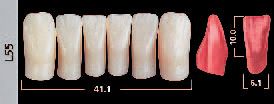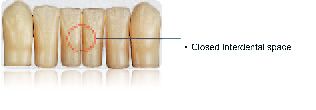How to spot quality in denture teeth
The introduction of SRPhonares® Nano Hybrid Composite denture teeth in 2010 represented true innovation in the dental market. Manufactured with Nano Hybrid Resin chemistry, this denture tooth line was designed to offer additional features over traditional resin teeth.
The introduction of SRPhonares® Nano Hybrid Composite denture teeth in 2010 represented true innovation in the dental market. Manufactured with Nano Hybrid Resin chemistry, this denture tooth line was designed to offer additional features over traditional resin teeth. The intent was to capture the virtues of composite resin esthetics and resistance to wear to meet today’s patients’ demands and expectations for high end removable prosthodontics (Fig. 1).
The success of the Phonares line of teeth combined with evolutionary enhancements of the composite chemistry have allowed for the introduction of SRPhonares II Expressive Denture Teeth. SRPhonares II sets new standards in removable prosthetics with optimized shape, shade and strength. The latest scientific knowledge has been implemented in the development and production of Phonares II to create a truly innovative tooth line (Fig. 2).
How to improve an innovator
SRPhonares II builds on the successful mould selection of Phonares with the addition of two new mandibular anterior moulds, L54 and L55 (Fig. 3). Each mould uses the “set and fit” design to ensure a natural proximal contact is achieved (Fig. 4).

Figure 3a

Figure 3b

Figure 4
These new moulds provide greater setup options and deliver a more patient specific prosthesis. Additionally, they are particularly suited for partial and combination cases. The updated mould combination table available from Ivoclar Vivadent makes mould integration easy by suggesting the appropriate lower mandibular mould based on the maxillary anterior selection (Fig. 5).

Figure 5
SRPhonares II also uses advanced shading techniques in the manufacturing process to deliver a warmer, more vital look. This new shade protocol matches the A-D shade standard and provides for optimized shade matching for partial and combination cases (Fig. 6). Additionally two new shades have been added to the existing Phonares offering, BL1 and BL2. These two new bleach shades extend the range of existing bleach options, while satisfying patient demands for a more natural bleach appearance.

Figure 6
The most exciting addition of the new SRPhonares II tooth line is the evolutionary advancement of the composite chemistry. This new generation Nano Hybrid Composite provides improved strength or “toughness” without sacrificing the esthetics and wear characteristics of the original formulation (Fig. 7). Composite resin chemistry by its nature is harder and therefore less resistant to fracture when compared with the softer and more resilient traditional polymethylmethacrylate (PMMA) denture tooth materials, especially when the teeth are compromised by excessive grinding because of insufficient restorative space. SRPhonares II has improved properties that will help not only to sustain the teeth in challenging restorative conditions but to also make them more tolerant to laboratory handling procedures.

Figure 7
Several investigations on fracture behavior were carried out during the development of SRPhonares II denture teeth (Figs. 8, 9).

Figure 8

Figure 9
Based on the results in Figs. 9 and 10, it has been proven that SRPhonares II has similar fracture resiliency to that of the proven cross-linked PMMA material in terms of fracture behavior.
Additional testing was conducted on crack propagation. Test samples measuring 20 mm in diameter and 5 mm in height were loaded with a spherical metal indenter (5 mm diameter) at a speed of 5 mm/min in a universal testing machine (Zwick). The minimum load at which cracks were detected was recorded (Fig. 10).

Figure 10
The results show the SRPhonares II composite chemistry is considerably more resistant to crack formation than composite materials of earlier generations. The SRPhonares evolution is similar to other new innovations in dentistry including CAD/CAM technology that has had several generations of development.
Leading scientists have studied the adverse events of chipping and tooth fracture issues with composite resin denture tooth chemistry and have designed new experimental technologies to improve our understanding and prevention of these issues. Although there is not a bullet proof answer to many of the restorative challenges, we feel quite confident that SRPhonares II will provide a successful alternative that will have improved esthetics and improved resistance to wear over traditional PMMA based denture teeth, while having similar fracture and chipping resistance.
SRPhonares II truly represents innovation for the dental professional and the patient. The enhancements to shape, shade and strength deliver a tooth line that provides the best possible prosthetic outcome both functionally and esthetically.
ACTIVA BioACTIVE Bulk Flow Marks Pulpdent’s First Major Product Release in 4 Years
December 12th 2024Next-generation bulk-fill dental restorative raises the standard of care for bulk-fill procedures by providing natural remineralization support, while also overcoming current bulk-fill limitations.